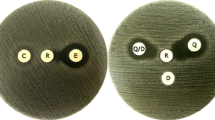Abstract
A number of bacteria hydrolyze esculin enzymatically to esculetin. This characteristic is used by taxonomists and clinical microbiologists in the differentiation and identification of bacteria, especially to distinguish Lancefield group D streptococci from non-group D organisms andListeria monocytogenes from morphologically similarErysipelothrix rhusipoathiae and diphtheroids. Conventional methods used for esculin hydrolysis require 4–48 h for completion. We developed and evaluated a medium which gives positive results more rapidly. The 2,330 isolates used in this study consisted of 1,680 esculin positive and 650 esculin negative organisms. The sensitivity and specificity of this method were compared with the PathoTec esculin hydrolysis strip and the procedure of Vaughn and Levine (VL). Of the 1,680 esculin positive organisms, 97% gave positive reactions within 30 minutes with the rapid test whereas PathoTec required 3–4 h incubation for the same number of organisms to yield a positive reaction.
Similar content being viewed by others
References
Baird-Parker AC (1974)Micrococcaceae. In: Buchanan RE, Gibbons NE (eds) Bergey's Manual of Determinative Bacteriology. The Williams & Wilkins Co., Baltimore, Md, pp 478–489
Barnes EM (1956) Tetrazolium reduction as a means of differentiatingStreptococcus faecalis fromStreptococcus faecium. J Gen Microbiol 14:57–68
Braunstein H, Tucker EB, Gibson BC (1969) Identification and significance ofStreptococcus agalactiae (Lancefield group B). Amer J Clin Pathol 51:207–213
Deibel RH, Seeley HW Jr (1974)Streptococcaceae. In: Buchanan RE, Gibbons NE (eds) Bergey's Manual of Determinative Bacterioloy. The Williams & Wilkins Co., Baltimore, Md., pp 490–509
Edberg SC, Gam K, Bottenbley CJ, Singer JM (1976) Rapid spot test for the determination of esculin hydrolysis. J Clin Microbiol 4:180–184
Facklam R, Moody M (1970) Presumptive identification of group D Streptococci: The bile-esculin test. Appl Microbiol 20:225–250
Facklam RR, Padula JF, Wortham EC, Cooksey RC, Rountree HA (1979) Presumptive identification of goup A, B and D streptococci on agar plate media. J Clin Microbiol 9:665–672
Graham NC, Bartley EO (1939) Some observations on the classification of enterococci. J Hyg 39:538–552
Hajna AA, Perry CA (1943) Comparative study of presumptive and confirmatory media for bacteria of the coliform group and for fecal streptococci. Am J Public Health 33:550–558
Hartman PA (1968) Miniaturized microbiological methods. Academic Press, Inc., New York, N.Y., pp 3–16
Hartman PA, Reinhold GW, Saraswat DS (1966) Media and methods for isolation and enumeration of the enterococci. Adv Appl Microbiol 8:253–289
Hermann GJ, Bickmann ST (1974)Corynebacteria. In: Lennette EH, Spaulding EH, Truant JP (eds) Manual of Clinical Microbiology, 2nd ed. American Society for Microbiology, Washington, D.C., pp 130–134
Isenberg DH, Gildberg D, Sampson J (1970) Laboratory studies with a selective enterococcus medium. Appl Microbiol 20:433–436
Ivler D (1974)Staphylococci. In: Lennette EH, Spaulding EH, Truant JP (eds) Manual of Clinical Microbiology, 2nd ed. American Society for Microbiology, Washington, D.C., pp 91–95
Killinger AH (1974)Listeria monocytogenes. In: Lennette EH, Spaulding EH, Truant JP (eds) Manual of Clinical Microbiology, 2nd ed. American Society for Microbiology, Washington, D.C., pp 135–139
Lee W (1972) Improved procedure for identification of group D enterococci with two new media. Appl Microbiol 24:1–3
Meulen H (1907) (Title unknown). K Akad Wet Amsterdam. In: Harrison FC, van der Leck J (1909) Aesculin bile salt media for water analysis. Zentralbl Bakteriol Parasitenkd Infektionskr Hyg Abt 2 22:547–551
Qadri SMH, DeSilva MI, Qadri SGM, Villarreal A (1979) Presumptive identification of enterococci from other D streptococci by a rapid sodium chloride tolerance test. Med Microbiol Immunol 167:197–203
Qadri SMH, Nichols CW, Qadri SGM (1978) Rapid sodium chloride tolerance test for presumptive identification of enterococci. J Clin Microbiol 7:238
Rochaix A (1924) Milieux à l'esculin pour le diano-stid différential des bactéries du group strepto-enter-pneumocoque. CR Soc Biol 90:771–772
Shattock PMF (1955) The identification and classification ofStreptococcus faecalis and some related streptococci. Ann Inst Pasteur Lille 7:95–100
Smith PB, Rhoden DL, Tomforhrde KM (1975) Evaluation of the PathoTec Rapid I-D System for identification ofEnterobacteriaceae. J Clin Microbiol 1:359–362
Vaughn RH, Levine M (1942) Differentiation of the “intermediate” coli-like bacteria. J Bacteriol 44:487–505
Weaver RE (1974)Erysipelothrix. In: Lennette EH, Spaulding EH, Truant JP (eds) Manual of Clinical Microbiology, 2nd ed. American Society for Microbiology, Washington, D.C., pp 140–142
Author information
Authors and Affiliations
Rights and permissions
About this article
Cite this article
Hussain Qadri, S.M., Smith, J.C., Zubairi, S. et al. Esculin hydrolysis by gram positive bacteria. Med Microbiol Immunol 169, 67–74 (1981). https://doi.org/10.1007/BF02171773
Received:
Issue Date:
DOI: https://doi.org/10.1007/BF02171773




